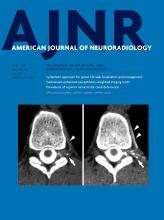Table of Contents
Perspectives
Review Articles
General Contents
- Gadolinium-Enhanced Susceptibility-Weighted Imaging in Multiple Sclerosis: Optimizing the Recognition of Active Plaques for Different MR Imaging Sequences
The authors analyzed the accuracy of gadolinium SWI for detecting the imaging evidence of active inflammation on MS plaques when a BBB dysfunction was demonstrated by a focal gadolinium-enhanced lesion and compared this technique with gadolinium-enhanced T1 spin-echo and T1 spin-echo with magnetization transfer contrast sequences. Differences in BBB dysfunction were evident in the 103 patients among gadolinium SWI, gadolinium T1 spin-echo, and gadolinium T1 magnetization transfer contrast. Gadolinium T1 magnetization transfer contrast demonstrated the highest number of active demyelinating plaques. Gadolinium SWI was highly correlated with gadolinium T1 magnetization transfer contrast in depicting acute demyelinating plaques and these techniques provided better performance compared with gadolinium T1 spin-echo.
- Moving Toward a Consensus DSC-MRI Protocol: Validation of a Low–Flip Angle Single-Dose Option as a Reference Standard for Brain Tumors
DSC-MR imaging using preload, intermediate (60°) flip angle and postprocessing leakage correction has gained traction as a standard methodology. Simulations suggest that DSC-MR imaging with flip angle = 30° and no preload yields relative CBV practically equivalent to the reference standard. Eighty-four patients with brain lesions were enrolled in this 3-institution study. Forty-three patients satisfied the inclusion criteria. DSC-MR imaging (3T, single-dose gadobutrol, gradient recalled-echo–EPI, TE=20–35 ms, TR=1.2–1.63 seconds) was performed twice for each patient, with flip angle = 30°–35° and no preload (P-) or provided preload (P+) for an intermediate flipangle = 60°. Compared with 60°/P+/C+, 30°/P-/C+ had closest mean standardized relative CBV, highest Lin concordance correlation coefficient, and lowest Bland-Altman bias.
- Measuring Glymphatic Flow in Man Using Quantitative Contrast-Enhanced MRI
In this technical report, the authors used MR myelography to demonstrate the feasibility of T1 mapping to quantify contrast concentration to analyze glymphatic flow in man. There is increasing interest in its use as a biomarker and potential therapeutic target in Alzheimer disease.
- Metallic Hyperdensity Sign on Noncontrast CT Immediately after Mechanical Thrombectomy Predicts Parenchymal Hemorrhage in Patients with Acute Large-Artery Occlusion
The authors evaluated 198 consecutive patients with acute ischemic stroke with large-vessel occlusion who underwent noncontrast CT immediately after mechanical thrombectomy between January 2014 and September 2018. The metallic hyperdensity sign was defined as a nonpetechial intracerebral hyperdense lesion in the basal ganglia and a maximum CT density of >90 HU. The metallic hyperdensity sign was found in 59 (29.7%) patients, and 51 (25.7%) patients had parenchymal hemorrhage at 24 hours. Patients with the metallic hyperdensity sign are more likely to have parenchymal hemorrhage than those without it.
- Imaging-Guided Superior Ophthalmic Vein Access for Embolization of Dural Carotid Cavernous Fistulas: Report of 20 Cases and Review of the Literature
In this retrospective study of 20 patients, the authors report the results of imaging-guided percutaneous superior ophthalmic vein access in dural carotid cavernous fistula treatment. Minimally invasive percutaneous imaging-guided access to the SOV can be obtained in situations in which conventional transvenousaccess to the cavernous sinus is not possible for managementof patients with dural carotid cavernous fistula. The authors conclude that direct imaging-guidedpercutaneous SOV access is a valuable and time-savingalternative route compared with direct surgical SOV access.
- Spontaneous Intracranial Hypotension: A Systematic Imaging Approach for CSF Leak Localization and Management Based on MRI and Digital Subtraction Myelography
Using spinal MR imaging to dichotomize patients with spontaneous intracranial hypotensioninto spinal longitudinal extradural CSF collection positive and negative populations accurately determines the nature of their underlying CSF leak (mechanical dural tear versus CSF venous fistula or nerve root sleeve leak), correctly predicts in whom autologous nondirected and directed epidural blood patch may work and in whom it will fail, and finally prescribes the positioning (prone versus decubitus) for subsequent dynamic myelography providing the most efficient pathway to definitive leak localization and repair. Using this systematic approach, the authors have been able to identify the exact site of CSF leakage in 27 (87%) of 31 consecutive patients referred to their institution with MR imaging evidence of SIH.



